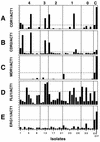Resistance mechanisms in clinical isolates of Candida albicans
- PMID: 12019079
- PMCID: PMC127245
- DOI: 10.1128/AAC.46.6.1704-1713.2002
Resistance mechanisms in clinical isolates of Candida albicans
Abstract
Resistance to azole antifungals continues to be a significant problem in the common fungal pathogen Candida albicans. Many of the molecular mechanisms of resistance have been defined with matched sets of susceptible and resistant clinical isolates from the same strain. Mechanisms that have been identified include alterations in the gene encoding the target enzyme ERG11 or overexpression of efflux pump genes including CDR1, CDR2, and MDR1. In the present study, a collection of unmatched clinical isolates of C. albicans was analyzed for the known molecular mechanisms of resistance by standard methods. The collection was assembled so that approximately half of the isolates were resistant to azole drugs. Extensive cross-resistance was observed for fluconazole, clotrimazole, itraconazole, and ketoconazole. Northern blotting analyses indicated that overexpression of CDR1 and CDR2 correlates with resistance, suggesting that the two genes may be coregulated. MDR1 overexpression was observed infrequently in some resistant isolates. Overexpression of FLU1, an efflux pump gene related to MDR1, did not correlate with resistance, nor did overexpression of ERG11. Limited analysis of the ERG11 gene sequence identified several point mutations in resistant isolates; these mutations have been described previously. Two of the most common point mutations in ERG11 associated with resistance, D116E and E266D, were tested by restriction fragment length polymorphism analysis of the isolates from this collection. The results indicated that the two mutations occur frequently in different isolates of C. albicans and are not reliably associated with resistance. These analyses emphasize the diversity of mechanisms that result in a phenotype of azole resistance. They suggest that the resistance mechanisms identified in matched sets of susceptible and resistant isolates are not sufficient to explain resistance in a collection of unmatched clinical isolates and that additional mechanisms have yet to be discovered.
Figures

References
-
- Calabrese, D., J. Bille, and D. Sanglard. 2000. A novel multidrug efflux transporter gene of the major facilitator superfamily from Candida albicans (FLU1) conferring resistance to fluconazole. Microbiology (United Kingdom) 11:2743-2754. - PubMed
-
- Fling, M. E., J. Kopf, A. Tamarkin, J. A. Gorman, H. A. Smith, and Y. Koltin. 1991. Analysis of a Candida albicans gene that encodes a novel mechanism for resistance to benomyl and methotrexate. Mol. Gen. Genet. 227:318-329. - PubMed
Publication types
MeSH terms
Substances
Grants and funding
LinkOut - more resources
Full Text Sources
Other Literature Sources
Medical

